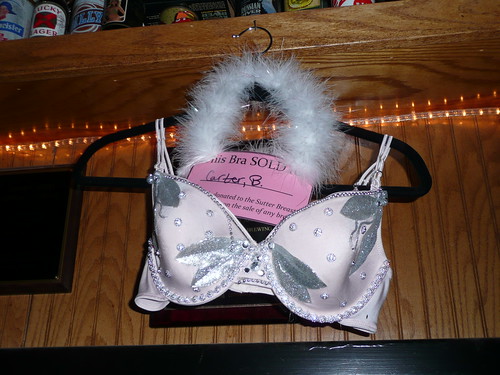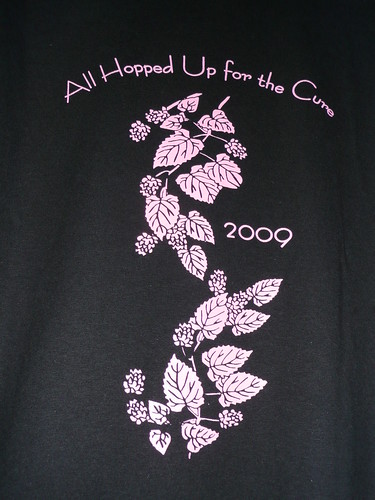![]()
Before I left for my Asheville vacation I stopped by Russian River Brewing to pick up some Pliny the Elder bottles to take with me to North Carolina as gifts — giving the gift of hops. All of which reminded me that October is Breast Cancer Awareness Month, a cause Vinnie and Natalie Cilurzo feel quite deeply about. It’s a big one for me, too. I lost my mother to breast cancer when I was only 21, when she was 42.
The Russian River brewpub is all decked out to remind people about breast cancer this month.

With a big pink ribbon on the beer list board.

The brewpub is decorated for Breast Cancer Awareness Month with all employees sporting this year’s “All Hopped Up For The Cure” t-shirts and baseball caps!
From their website: “Once again, we are donating 100% of the proceeds from t-shirt and cap sales, 5% of the proceeds of sales of Aud Blonde, and accepting donations on behalf of the “Sutter Breast Care Center.”

If that wasn’t enough, we are partnering for a second time with Revolution Moto (RevMoto) and raffling off an adorable Pink Vespa 50cc! Raffle tickets are only $10, 3 for $25. If you live outside of the area and want to participate in the raffle, you may send me a check made out to the “Sutter Breast Care Center” and I will fill out raffle tickets for you. However, if you should be the lucky winner, you will responsible for picking up your scooter and any expenses related to getting it home. Russian River Brewing Co. and RevMoto are not responsible for shipping, handling, delivery, or anything else pertaining to you picking up your prize! We donated it, you pick it up! Raffle tickets available at RRBC and RevMoto, and the raffle will be held at our Halloween Party on October 31st! You need not be present to win, but we will call you on your cell phone no matter how late it is!

What else? Oh, don’t forget the ”Scooters For Hooters” ride on October 25th from 2-4pm. The entrance fee is one of our “All Hopped Up For The Cure” t-shirts, and the ride begins at RevMoto by the pub. More info available at RevMoto! For a complete run-down of all the shows/activities this month, check out the music calendar on our website. Each band is helping us raise money and awareness all month long!
More from the website: “You can also drink Aud Blonde at the pub, or just make a donation to the “Sutter Breast Care Center”. There is a wine barrel located by the juke box which I will open on November 1st.”

There were colorful bras hanging throughout the brewpub.

Apparently the bras can be bought and the proceeds donated to the Sutter Breast Care Center.

Surprisingly, this fetching polka dot bra is still available.

Order your own “All Hopped Up For The Cure” t-shirt online.
“All Hopped Up For The Cure” t-shirts and baseball caps are available on our website for our distant friends and family! The back of this year’s shirt is another cool design by my Mom, who also does many of our logos. Tony at Seacliff Designs did a beautiful job with the shirts and gave us a screaming deal so we can donate even more money to the cause! Shirts and hats are in limited supply, so don’t delay!




